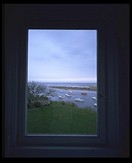
Mamiya 7 II
reviewed for photo.net by Philip Greenspun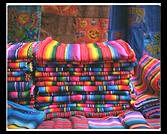

|
Mamiya 7 IIreviewed for photo.net by Philip Greenspun |

|
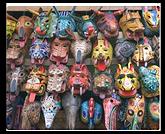 About to leave for a three week trip to Australia, I scanned the 20
cameras in my closet. The 20-lens Canon EOS system beckoned. It is
flexible, reasonably small and lightweight, and fast thanks to
automated exposure, focus, and film advance. However, the last few
trips I'd taken with the EOS it transpired that the 50/1.4 lens stayed
on the camera 95% of the time. The extra 19 lenses stayed at home or
in the suitcase. If one is going out among the streets with a camera
and wants a normal perspective, the 6x7 cm negative produced by a
Mamiya 7 is a much more satisfying result. Because the rangefinder
design does not require a mirror or prism, the overall weight of the
Mamiya and 80/4 lens is similar to that of an EOS-3 with 50/1.4 lens.
Same weight, 4.5X larger negative.
About to leave for a three week trip to Australia, I scanned the 20
cameras in my closet. The 20-lens Canon EOS system beckoned. It is
flexible, reasonably small and lightweight, and fast thanks to
automated exposure, focus, and film advance. However, the last few
trips I'd taken with the EOS it transpired that the 50/1.4 lens stayed
on the camera 95% of the time. The extra 19 lenses stayed at home or
in the suitcase. If one is going out among the streets with a camera
and wants a normal perspective, the 6x7 cm negative produced by a
Mamiya 7 is a much more satisfying result. Because the rangefinder
design does not require a mirror or prism, the overall weight of the
Mamiya and 80/4 lens is similar to that of an EOS-3 with 50/1.4 lens.
Same weight, 4.5X larger negative.
What exactly is a Mamiya 7?
The Mamiya 7 is a lightweight rangefinder 6x7-format camera with
interchangeable lenses. It is probably the only 6x7 camera with
interchangeable lenses that is practical for travel or street
photography.
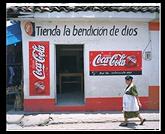 After a few rolls, I fell into a rhythm with this camera such that I had
a higher successful image rate than with the Canon EOS system that I've
used regularly for six years. The key to the Mamiya's
photographer-friendliness is that the camera's engineers must have read
About
Face, where Alan Cooper reminds programmers "No matter how
cool your interface, it would be better if there were less of it."
There aren't that many controls on the Mamiya 7 and it is therefore easy
to keep in one's mind the fact that, for example, exposure compensation
has been set to +1 f-stop. Because one's mind isn't occupied with a
raft of autofocus settings, it is easy to remember to remove the lens
cap before pushing the shutter release.
After a few rolls, I fell into a rhythm with this camera such that I had
a higher successful image rate than with the Canon EOS system that I've
used regularly for six years. The key to the Mamiya's
photographer-friendliness is that the camera's engineers must have read
About
Face, where Alan Cooper reminds programmers "No matter how
cool your interface, it would be better if there were less of it."
There aren't that many controls on the Mamiya 7 and it is therefore easy
to keep in one's mind the fact that, for example, exposure compensation
has been set to +1 f-stop. Because one's mind isn't occupied with a
raft of autofocus settings, it is easy to remember to remove the lens
cap before pushing the shutter release.
The only thing of which you must be careful is that you have the 120/220 pressure plate set properly. One twist sets both the pressure plate and the film counter appropriately and a small window on the camera back confirms the setting externally. However, it is best to stick with either 120 (10 exposures per roll) or 220 film (20 exposures per roll) for an entire trip so that you don't have to worry about finishing a roll only to find out that the pressure plate was improperly set (resulting in unsharp images at wide apertures).
Right before leaving, I borrowed a Mamiya 7 II system including the 43mm
superwide, 80mm normal, and 150mm portrait lenses. The photos that
you see illustrating this article were all taken in Guatemala.
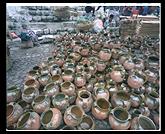 Background: This is not a camera that you can just grab and go.
Before you change lenses you must turn a dial on the bottom of the
camera to close a light curtain. After fitting the new lens and
composing your picture, you invariably will have forgotten to press
the little release button to open the light curtain again. The camera
has electronic interlocks to prevent you from wasting a roll with
blank frames but the bottom line is that people who haven't read the
manual won't get very far with this camera.
Background: This is not a camera that you can just grab and go.
Before you change lenses you must turn a dial on the bottom of the
camera to close a light curtain. After fitting the new lens and
composing your picture, you invariably will have forgotten to press
the little release button to open the light curtain again. The camera
has electronic interlocks to prevent you from wasting a roll with
blank frames but the bottom line is that people who haven't read the
manual won't get very far with this camera.
Framing remains a challenge, however. At infinity, the film captures about 20% more than what is within the bright lines (i.e., you might get a street sign that will have to be cropped out in the lab). Only when the lens is focussed close do the bright lines correspond to what is captured on film.
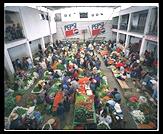 With the 43mm lens, taking a picture requires the following steps:
With the 43mm lens, taking a picture requires the following steps:
You can support photo.net by buying one now at Adorama .

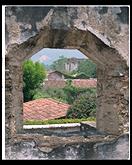
With the 43mm lens...
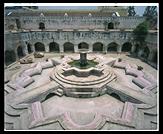



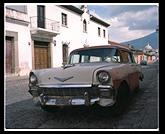

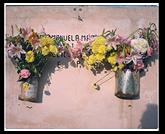





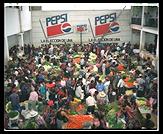
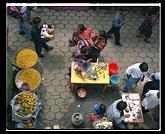
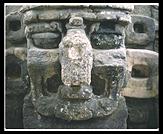
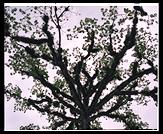


Let's shift gears now, back to Cape Cod, Massachusetts. This has been
the subject of an earlier photo.net
exhibit but a new house in Chatham and the newly arrived Mamiya
created an opportunity to take some more snapshots. First, let's look
at the views from the house and deck:
